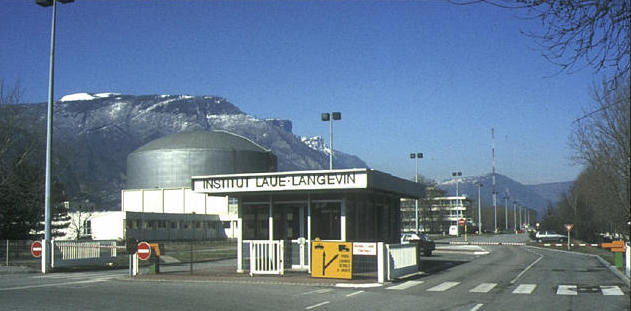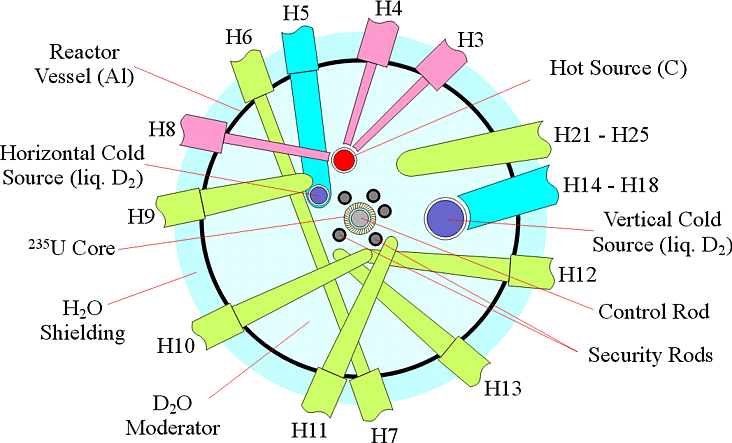 |
Nuclear Reactors |
 |
Nuclear Reactors |
Nuclear Reactors
In contrast to synchrotrons, the cost and security of running a nuclear research reactor means that there are only a few in operation around the world. Much of the description that follows is specific to the nuclear reactor at the Institut Laue Langevin (ILL) in Grenoble, France, which produces the world's highest continuous neutron flux for research use. However, the underlying principles behind the design and operation of the reactor and associated neutron instruments are quite generic. A photograph of the site entrance of the ILL taken in the 1980's (before the development of the European Synchrotron Radiation Facility on the adjacent site) shows the grey dome of the nuclear reactor building.

The nuclear reactor uses the fission reaction of 235U to produce an intense flux of neutrons at the heart of the reactor. Typically several kilograms of uranium are required, and at a reactor like the one at the ILL Institut Laue Langevin (ILL), uses highly-enriched (97%) 235 uranium. One of the by-products of the nuclear reaction is a lot of heat (63 MW at ILL) which is unusable from a research reactor, being low-grade energy.
At the ILL, the reactor is cooled with heavy water (D2O) at about 35°C, which is heat-exchanged with light water (H2O) cooled by the local river. An important part of the design of the reactor is the reflector and moderator: in order to keep the nuclear reaction going, the neutrons must be slowed down and reflected back into the core; at the ILL the D2O acts as both coolant and moderator. A diagram of the reactor core at the ILL showing some of the key features is given below:

A radiation shield is provided by light water, which completely surrounds the central the reactor vessel as indicated above. The view from above the reactor is shown in the photograph below, the blue light being formed by the effect of Cerenkov radiation:

Neutron beam tubes made of aluminium (and labelled H1 to H25 in the above figure) go right into the heart of the reactor vessel as shown. To minimize transmission of the enormous γ radiation produced by the nuclear reaction, all of the beam tubes are pointed away from the fuel element at the centre of the vessel. The beam tubes are made of thin-walled aluminium metal, which is virtually transparent to neutrons. They are either evacuated or filled with an inert gases such as helium at low pressure so that neutrons keep travelling in straight lines within them.
The result of the heavy water moderator is to produce neutrons with a
Maxwellian wavelength distribution corresponding to the temperature of
the coolant.
This results in neutrons whose wavelengths are approximately

For many experiments, it is useful to produce neutrons where the maximum in the flux is either at short or longer wavelengths. This can be done by using either a cold or hot moderator within the heavy water coolant and having the beam tubes point at the hot or cold moderator. These moderators are shown in red (hot) or dark blue (cold) in the top figure; the hot and cold beam tubes aligned towards them are shown in pink and light blue, respectively.
To cool neutrons to longer wavelengths, say in the range
Most powder neutron diffractometers at reactor sources utilize thermal neutron sources, though for special work, instruments may be available for powder diffraction studies on both cold and hot sources.
| © Copyright 1997-2006. Birkbeck College, University of London. | Author(s): Jeremy Karl Cockcroft |